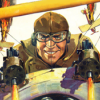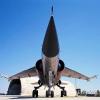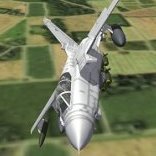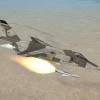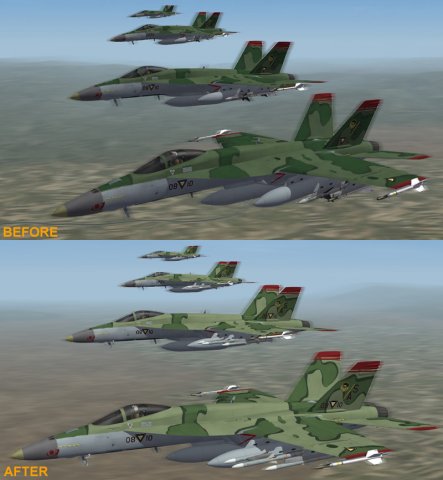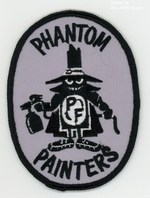Leaderboard
Popular Content
Showing most liked content on 09/08/2017 in all areas
-
5 pointsYou're welcome - this is a fun hobby, so everybody wins. This morning, I spent a little time on the Chinese Chirri. EDIT: Click on image below to view original hi-res image.
-
2 pointsToday Guys, I would like to share this kind of Development Update with you. We are working on the Su-22 Variants that were used in the Iran Iraq conflict, the russian builds and the Peru versions. As you read those news, we are working on those birds. Pits are WIP right now, so the skin polishing and 3D model debuggin is going on right now For now, some pics of the Su-22 And here the early version with two wingfences only and the "fat ass" from the Su-7 fuselage A render of the Airbrakesystem
-
2 pointsGot the gunner mapped and textured. I'll do some of the more challenging stuff, such as the crew, but leave the majority of the artwork for Quack to do.
-
1 pointI'm very happy to present the new CAF team plane, the MiG-19SK. The CAF team is formed by Cocas, Wrench, Coupi, Nyghtfall, Valastur and Stratos. The MiG-19SK has been a truly team effort to deliver a fun, challenging and realistic plane for a early carrier based soviet navy squadrons. It all started thanks to Dizzyfugu, a WhatIf master, with this entry. https://www.flickr.com/photos/dizzyfugu/page22 Then everything started to move forward in the CAF team. We asked permission to Dizzyfugu to release the plane, and he kindly agreed, so kudos to him! Thanks mate! So without more waiting, the MiG-19SK story... After the success of the Soviet Union’s first carrier ship, the Moskva Class (Projekt 1123, also called „Кондор“/„Kondor“) cruisers in the mid 1960s, the country became more ambitious. This resulted in Project 1153 Orel (Russian: Орёл, Eagle), a planned 1970s-era Soviet program to give the Soviet Navy a true blue water aviation capability. Project Orel would have resulted in a program very similar to the aircraft carriers available to the U.S. Navy. The ship would have been about 75-80,000 tons displacement, with a nuclear power plant and carried about 70 aircraft launched via steam catapults – the first Soviet aircraft carrier that would be able to deploy fixed-wing aircraft. Beyond this core capability, the Orel carrier was designed with a large offensive capability with the ship mounts including 24 vertical launch tubes for anti-ship cruise missiles. In the USSR it was actually classified as the "large cruiser with aircraft armament". Anyway, the carrier needed appropriate aircraft, and in order to develop a the aircraft major design bureaus were asked to submit ideas and proposals in 1959. OKB Yakovlev and MiG responded. While Yakovlev concentrated on the Yak-36 VTOL design that could also be deployed aboard of smaller ships without catapult and arrester equipment, Mikoyan-Gurevich looked at navalized variants of existing or projected aircraft. While land-based fighters went through a remarkable performance improvement during the 60ies, OKB MiG considered a robust aircraft with proven systems and – foremost – two engines to be the best start for the Soviet Union’s first naval fighter. “Learning by doing”, the gathered experience would then be used in a dedicated new design that would be ready in the mid 70ies when Project 1153 was ready for service, too. Internally designated “I-SK” or “SK-01” (Samolyot Korabelniy = carrier-borne aircraft), the naval fighter was based on the MiG-19 (NATO: Farmer), which had been in production in the USSR since 1954. Faster and more modern types like the MiG-21 were rejected for a naval conversion because of their poor take-off performance, uncertain aerodynamics in the naval environment and lack of ruggedness. The MiG-19 also offered the benefit of relatively compact dimensions, as well as a structure that would carry the desired two engines. Several innovations had to be addresses: - A new wing for improved low speed handling - Improvement of the landing gear and internal structures for carrier operations - Development of a wing folding mechanism - Integration of arrester hook and catapult launch devices into the structure - Protection of structure, engine and equipment from the aggressive naval environment - Improvement of the pilot’s field of view for carrier landings - Improved avionics, esp. for navigation Work on the SK-01 started in 1960, and by 1962 a heavily redesigned MiG-19 was ready as a mock-up for inspection and further approval. The “new” aircraft shared the outlines with the land-based MiG-19, but the nose section was completely new and shared a certain similarity to the experimental “Aircraft SN”, a MiG-17 derivative with side air intakes and a solid nose that carried a. Unlike the latter, the cockpit had been moved forward, which offered, together with an enlarged canopy and a short nose, an excellent field of view for the pilot. On the SK-01 the air intakes with short splitter plates were re-located to the fuselage flanks underneath the cockpit. In order to avoid gun smoke ingestion problems (and the lack of space in the nose for any equipment except for a small SRD-3 Grad gun ranging radar, coupled with an ASP-5N computing gun-sight), the SK-01’s internal armament, a pair of NR-30 cannon, was placed in the wing roots. The wing itself was another major modification, it featured a reduced sweep of only 33° at ¼ chord angle (compared to the MiG-19’s original 55°). Four wing hardpoints, outside of the landing gear wells, could carry a modest ordnance payload, including rocket and gun pods, unguided missiles, iron bombs and up to four Vympel K-13 AAMs. Outside of these pylons, the wings featured a folding mechanism that allowed the wing span to be reduced from 10 m to 6.5 m for stowage. The fin remained unchanged, but the stabilizers had a reduced sweep, too. The single ventral fin of the MiG-19 gave way to a fairing for a massive, semi-retractable arrester hook, flanked by a pair of smaller fins. The landing gear was beefed up, too, with a stronger suspension. Catapult launch from deck was to be realized through expandable cables that were attached onto massive hooks under the fuselage. The SK-01 received a “thumbs up” in March 1962 and three prototypes, powered by special Sorokin R3M-28 engines, derivatives of the MiG-19's RB-9 that were adapted to the naval environment, were created and tested until 1964, when the type – now designated MiG-SK – went through State Acceptance Trials, including simulated landing tests on an “unsinkalble carrier” dummy, a modified part of the runway at Air Base at the Western coast of the Caspian Sea. Not only flight tests were conducted at Kaspiysk, but also different layouts for landing cables were tested and optimized as well. Furthermore, on a special platform at the coast, an experimental steam catapult went through trials, even though no aircraft starts were made from it – but weights hauled out into the sea. Anyway, the flight tests and the landing performance on the simulated carrier deck were successful, and while the MiG-SK (the machine differed from the MiG-19 so much that it was not recognized as an official MiG-19 variant) was not an outstanding combat aircraft, rather a technology carrier with field use capabilities. The MiG-SK’s performance was good enough to earn OKB MiG an initial production run of 20 aircraft, primarily intended for training and development units, since the whole infrastructure and procedures for naval aviation from a carrier had to be developed from scratch. These machines were built at slow pace until 1965 and trials were carried out in the vicinity of the Black Sea and the Caspian Sea. FROM NOW ON IS MY WORK. STRATOS. With the reception of the first new carrier in late 1965, the new aircraft began sea trials during the spring of 1966 and for summer the first planes were permanently deployed on board. The ship and it's planes began a cruise around the world doing good will port visits showing the flag and the new capabilities of the Soviet Navy. The carrier was permanently escorted by USN info gathering ships monitoring the capabilities of the new vessel and its air component. The first real deployment with combat ocured in the Pacific Ocean in 1969, in a dare move, the carrier slipped into the Yellow Sea during the night and launched it's aircraft at first light, the planes strike several military facilities in China mainland, specially around Shangai, and the first A-A combat took place when a pair of SK's engaged intercepting J-6 of the PLAAF while escorting strike armed SK's. All the soviets returned to the carrier that was already steaming to get out of the South China sea trough Tsushima straits. By early 1972, new models are being introduced into the fleet and the SK's started to show their age in the fast pace of aviation during Cold War, so as soon as the new models completed the air component the SK's were passed to train new naval pilots on the fleet training installations in Crimea, were it served with distinction until the last cells were too worn out to be safely operated beyond 1980. So the SK's story came to an end with the honor of being the first real combat aircraft onboard soviet carriers, and the plane that first tasted the blood for carrier based pilots. And some pictures of the plane itself. There will be several skins included in the release. The plane will be available for download pretty soon. Thanks.
-
1 pointI'm looking for someone who want to do hitboxes. I'm out for 2 weeks and plane needs lot of testing, also INI files are to check.
-
1 pointYes, I agree The worse problem is for the Spad : Spad VII 150 hp and Spad VII 180 hp were very different : The firts one had lower performances than the early Alvatros (DII and III) while the second was better Worse for the the Spad XIII : the 200 hp was hardly more than an unreliable VII 180hp with 2 Machine guns, the 220 hp was better in performances, while the 235 hp was better overall (and especially in reliability). Add to this that machine giuns also changed heavily (especially synchronisation systems)
-
1 pointI have ready the like 2 more skins for Peru, one for Lybia and got the Angola Missing, wanna see them too? We still have an update made by the US to Peruvian Su-22's, so give us time, is all we ask for, a bit of time, we promise a good model to play with.
-
1 point
-
1 point
-
1 pointOn the subject of location, this is where I live. I put up with idiots for 20 years so I could retire 400 miles away from the closest big city (Denver).
-
1 point
-
1 point
-
0 points
Version
5,080 downloads
+-----------------------------------------------------------------------------------------------------+ | | | GRUMMAN F-14A+ TOMCAT | | The F-14A+ Tomcat the best fleet defender. | +-----------------------------------------------------------------------------------------------------+ With the gracious permission of; The Mirage Factory and Olivier ANGUILLE (BPAo); This update includes the avionics upgrade by Sandmartin and Batman1978 which uses the avionics70 file to provide improved HUD and air to air radar and tracking capabilities and the TCS mod. This TCS mod provides a boresighted view only and does not (yet) track selected targets. The Radar Warning Receiver (RWR) has been updated and includes the implementation originally developed by wpnssgt. This variation of the original F-14A in one of the later operational configurations to guard the fleet; the F-14A+. This is a minor tweak of the ini files to update the engines and radar. The F-14A+ included the same engines for the F-14D but this version did not include the air to ground capability of the F-14D. This is not the pre-production development mod but the fleet operational version which was also later referred to as the F-14B. Both the F-14A+ and the F-14B were employed in the fleet at the same time, with the F-14A+ generally deployed to the Pacific and the F-14B deployed to the Atlantic (the principle difference between the two aircraft being whether the squadron was in the Pacific or the Atlantic Fleet). This aircraft was withdrawn from fleet service in 2006 and replaced by the F-18F in the air to air role. All F-14's received air to ground capabilities in 1995 which are included in this model with the addition of conventional air to ground bombing capabilities. The squadrons which deployed with the F-14A+ were VF-11, VF-24, VF-32, VF-74, VF-102, VF-103, VF-142 and VF-143. Those skins are not included in this file and must be downloaded and installed separately. The squadron skins included in this model are the original ones in the Mirage Factory F-14A. I recommend deleting the squadron skins in this model and loading the others. Since permission to include those skins was not given, those skins are not included here. export : None Just unzip this entire folder into your WOE/Ojects/Aircraft folder. Note -1. The avionics upgrade by Sandmartin and Batman1978 uses the avionics70 file to provide improved HUD and air to air radar and tracking capabilities. This avionics70 mod does NOT work in a Wings Over Vietnam (and possibly not in Strike Fighter) only install. So if you are using a WoV install you will need to use the alternate cockpit using the avionics60 version. The TCS mod works in both versions. Note; the missile stations are designed to pick up Active Radar Homing missiles and will employ the AIM-7 and AIM-54 series air to air missiles. The model here will also pick up the AIM-120 series in the sim, but the aircraft was never wired or certified to carry that missile. So if you want the realism, don't load that one. Good hunting! Typhoid +-----------------------------------------------------------------------------------------------------+ SFP1 Model Plane 3D : BPAo Textures : Column5 (templates) FM : Column5 Sounds : Aaron Swindle Camos VF1 : Column 5 VF2 : Sundowner VF154 : USAFMTL VF31 : Sundowner VF84 : Sundowner VX4 : Sundowner Cockpit 3D : based on JT's from Thirdwire public cockpit, modified by BPAo Textures : based on Thirdwire, news BPAo, HUD from ArmourDave team (Sal, Lansen, Rafael et AD himself) Effects : Deuces, JSF_Aggie Pilote Texture : Pappychecksix Weapons 3D : Crab_02 Textures : BPAo Tank 3D : Crab_02 Textures : BPao Original F-14A Test Team Manetsim, Sony Tuckson, Nico, Column5 +-----------------------------------------------------------------------------------------------------+
Important Information
By using this site, you agree to our Terms of Use, Privacy Policy, and We have placed cookies on your device to help make this website better. You can adjust your cookie settings, otherwise we'll assume you're okay to continue..

